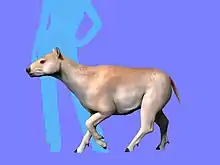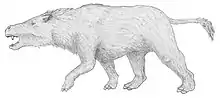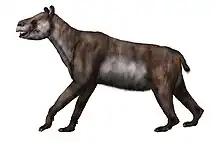Notiolofos
Notiolofos is an extinct genus of sparnotheriodontid ungulate from the order Litopterna. The animal lived during the Eocene, in modern-day Antarctica. The genus contains two species, N. arquinotiensis, the type species, and N. regueroi.
| Notiolofos | |
|---|---|
| Scientific classification | |
| Domain: | Eukaryota |
| Kingdom: | Animalia |
| Phylum: | Chordata |
| Class: | Mammalia |
| Order: | †Litopterna |
| Family: | †Sparnotheriodontidae |
| Genus: | †Notiolofos Bond et al., 2009 |
| Type species | |
| †Notiolofos arquinotiensis Bond et al. 2006 | |
| Other species | |
| |
| Synonyms | |
|
Genus synonymy
| |
Description
Notiolofos was originally named in 2006 by Bond et al., as Notolophus arquinotiensis, on the basis of a few fossil teeth.[1] However, after the genus was named, it became clear that the name Notolophus was already in use by a genus of moths, and the genus name was subsequently changed to Notiolofos by Bond et al. in 2009.[2] The second species in the genus, Notiolofos regueroi, was named in 2017 by Gelfo, Lopéz & Santillana, based on a single fossil molar.[3]
Fossils of N. arquinotiensis have been found in multiple layers of the La Meseta Formation of Seymour Island, Antarctica, and are dated from 55 to 34 million years ago. However, N. regueroi is only known from the Cucullaea I layer from the Upper Ypresian, dating to 53 million years ago.[4] When Notiolofos lived, Antarctica was still connected to South America by a land bridge, as a remainder of the supercontinent Gondwana.[5]
N. regueroi was around the size of a sheep, with an estimated weight of 25 to 57 kilogrammes. N. arquinotiensis was much larger, with an estimated weight of 400 kilogrammes, around the size of a muskox. It is thought to have been a browser.
Taxonomy
Notiolofos is a part of the family Sparnotheriodontidae,[1] and is most closely related to Victorlemoinea, fossils of which have been found in the Upper Paleocene and Lower Eocene of Patagonia and the Brazilian Itaboraí basin.
References
- Bond, M.; Reguero, M. A.; Vizcaíno, S. F.; Marenssi, S. A. (2006-01-01). "A new 'South American ungulate' (Mammalia: Litopterna) from the Eocene of the Antarctic Peninsula". Geological Society, London, Special Publications. 258 (1): 163–176. doi:10.1144/GSL.SP.2006.258.01.12. ISSN 0305-8719. S2CID 140546667.
- Bond, Mariano; Reguero, Marcelo A.; Vizcaíno, Sergio F.; Marenssi, Sergio A.; Ortiz-Jaureguizar, Edgardo (2009-09-12). "Notiolofos, a replacement name for Notolophus Bond, Reguero, Vizcaíno, and Marenssi, 2006, a preoccupied name". Journal of Vertebrate Paleontology. 29 (3): 979. doi:10.1671/039.029.0321. ISSN 0272-4634. S2CID 84808731.
- Gelfo, Javier N.; López, Guillermo M.; Santillana, Sergio N. (2017). "Eocene ungulate mammals from West Antarctica: implications from their fossil record and a new species". Antarctic Science. 29 (5): 445–455. doi:10.1017/S0954102017000244. ISSN 0954-1020. S2CID 86868504.
- Gelfo, Javier N. (2016). "Considerations about the Evolutionary Stasis of Notiolofos arquinotiensis (Mammalia: Sparnotheriodontidae), Eocene of Seymour Island, Antarctica". Ameghiniana. 53 (3): 316–332. doi:10.5710/AMGH.14.09.2015.2934. ISSN 0002-7014. S2CID 129877349.
- Reguero, Marcelo A.; Gelfo, Javier N.; López, Guillermo M.; Bond, Mariano; Abello, Alejandra; Santillana, Sergio N.; Marenssi, Sergio A. (2014-12-01). "Final Gondwana breakup: The Paleogene South American native ungulates and the demise of the South America–Antarctica land connection". Global and Planetary Change. SCOTIA ARC EVOLUTION: GLOBAL IMPLICATIONS. 123: 400–413. doi:10.1016/j.gloplacha.2014.07.016. hdl:11336/33269. ISSN 0921-8181.

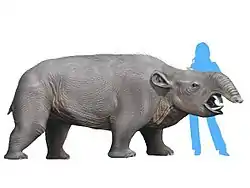
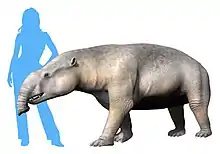
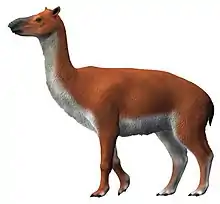
.jpg.webp)
